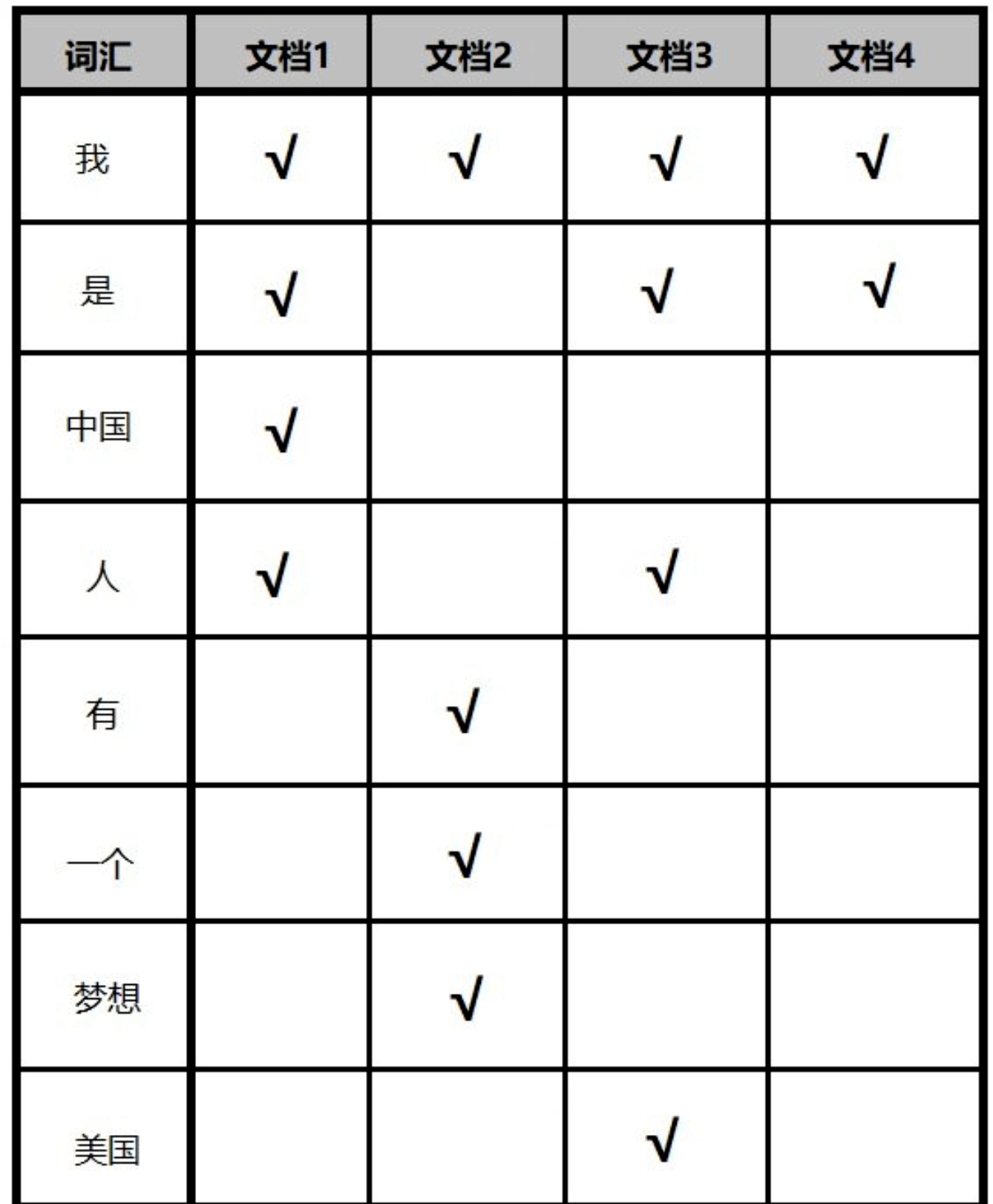Lucene
目录
1. Lucene概述
1.1 什么是Lucene
Lucene是一个全文搜索框架,而不是应用产品。因此它并不像baidu或者google那样拿来就能用,它只是提供了一些工具让你能实现这些产品。
Lucene的发明者Doug Cutting也同样是Hadoop的创造者。
-
Lucene能做什么?
要回答这个问题,先要了解Lucene的本质。
实际上Lucene的功能很单一,说到底,就是你给它若干个字符串,然后它为你提供一个全文搜索服务,告诉你你要搜索的关键词出现在哪里。
知道了这个本质,你就可以发挥想象做任何符合这个条件的事情了。
你可以把站内新闻都索引了,做个资料库;
你可以把一个数据库表的若干个字段索引起来,那就不用再担心因为"%like%"而锁表了;
你也可以写个自己的搜索引擎。
-
Lucene效率如何?
下面给出一些N年前的测试数据,如果你觉得可以接受,那么可以选择。
-
测试一:250万记录,300M左右文本,生成索引380M左右,800线程下平均处理时间300ms。
-
测试二:37000记录,索引数据库中的两个varchar字段,索引文件2.6M,800线程下平均处理时间1.5ms。
-
1.2 Lucene的原理
-
Lucene为什么这么快?
-
倒排索引
-
压缩算法
-
二元搜索
-
-
倒排索引
先要了解一下数据库的like搜索为什么那么慢:

执行like搜索时,数据库要遍历每条数据,并在每次遍历的过程中匹配关键词。
也就是说,慢的原因是在记录中搜索关键词,所以可以把这个过程反过来,以关键词搜索记录。
倒排索引是将每个文档(数据库中的记录)中的词汇提前取出,建立“词汇-文档索引”。
以上表中数据为例,将其中所有词汇取出,并建立索引:

-
Lucene的工作方式
Lucene提供的服务实际包含两部分:一入一出。
所谓入是写入,即将你提供的源(本质是字符串)写入索引或者将其从索引中删除;
所谓出是读出,即向用户提供全文搜索服务,让用户可以通过关键词定位源。
-
写入流程:
源字符串首先经过analyzer处理,包括:分词(分成一个个单词)、去除停用词(stopword,可选)。
将源中需要的信息加入Document的各个Field中,并把需要索引的Field索引起来,把需要存储的Field存储起来。
将索引写入存储器,存储器可以是内存或磁盘。
-
读出流程:
用户提供搜索关键词,经过analyzer处理。
对处理后的关键词搜索索引找出对应的Document。
用户根据需要从找到的Document中提取需要的Field。
-
2. Lucene的使用
2.1 准备
-
引入依赖
? ? ? ?<!-- https://mvnrepository.com/artifact/org.apache.lucene/lucene-highlighter --> ? ? ? ?<dependency> ? ? ? ? ? ?<groupId>org.apache.lucene</groupId> ? ? ? ? ? ?<artifactId>lucene-highlighter</artifactId> ? ? ? ? ? ?<version>9.5.0</version> ? ? ? ?</dependency> ? ? ? ? ?<!-- https://mvnrepository.com/artifact/org.apache.lucene/lucene-queryparser --> ? ? ? ?<dependency> ? ? ? ? ? ?<groupId>org.apache.lucene</groupId> ? ? ? ? ? ?<artifactId>lucene-queryparser</artifactId> ? ? ? ? ? ?<version>9.5.0</version> ? ? ? ?</dependency> ? ? ? ? ? ?<!-- https://mvnrepository.com/artifact/org.apache.lucene/lucene-analyzers-common --> ? ? ? ?<dependency> ? ? ? ? ? ?<groupId>org.apache.lucene</groupId> ? ? ? ? ? ?<artifactId>lucene-analyzers-common</artifactId> ? ? ? ? ? ?<version>8.11.2</version> ? ? ? ?</dependency> ? ?<!--流操作 --> <dependency> ? ? ? ? ? ?<groupId>commons-io</groupId> ? ? ? ? ? ?<artifactId>commons-io</artifactId> ? ? ? ? ? ?<version>2.11.0</version> ? ? ? ?</dependency> ? -
准备基础数据
创建两个目录,例如
D:/data和D:/index在data目录中添加一些数据,可以保存几个网页
2.2 生成索引
private static final String INDEX_DIR = "/Users/whitecamellia/Desktop/lucene/index";
private static final String DATA_DIR = "/Users/whitecamellia/Desktop/lucene/data";
?
@Test
public void createIndex() throws Exception {
?
? ?// 获取存放索引的目录
? ?Directory directory = FSDirectory.open(Paths.get(INDEX_DIR));
? ?// 创建IndexWriter的默认配置
? ?IndexWriterConfig indexWriterConfig = new IndexWriterConfig();
? ?// 创建IndexWriter
? ?IndexWriter indexWriter = new IndexWriter(directory, indexWriterConfig);
?
? ?// 获取存放原始数据的目录
? ?File dataDir = new File(DATA_DIR);
? ?// 遍历目录中的文件
? ?for (File data : dataDir.listFiles()) {
? ? ? ?if (data.isFile()) {
? ? ? ? ? ?// 创建文档
? ? ? ? ? ?Document document = new Document();
?
? ? ? ? ? ?String title = data.getName();
? ? ? ? ? ?// 向title Field域中加入文件名
? ? ? ? ? ?document.add(new TextField("title", title, Field.Store.YES));
?
? ? ? ? ? ?String content = FileUtils.readFileToString(data, "utf-8");
? ? ? ? ? ?// 向content Field域中加入文件内容
? ? ? ? ? ?document.add(new TextField("content", content, Field.Store.YES));
?
? ? ? ? ? ?indexWriter.addDocument(document);
? ? ? }
? }
? ?indexWriter.close();
}2.3 全文检索
@Test
public void search() throws Exception {
? ?String keyword = "何平";
?
? ?// 获取索引目录
? ?Directory directory = FSDirectory.open(Paths.get(INDEX_DIR));
? ?// 创建标准分词器
? ?Analyzer analyzer = new StandardAnalyzer();
? ?// 通过索引创建出IndexSearcher
? ?DirectoryReader reader = DirectoryReader.open(directory);
? ?IndexSearcher indexSearcher = new IndexSearcher(reader);
?
? ?// 指定搜索域
? ?QueryParser queryParser = new QueryParser("title", analyzer);
? ?// QueryParser queryParser = new QueryParser("content", analyzer);
? ?// 处理搜索关键词
? ?Query query = queryParser.parse(keyword);
?
? ?// 搜索整个索引,并获取前5条
? ?TopDocs topDocs = indexSearcher.search(query, 5);
? ?System.out.println("共搜索出 " + topDocs.totalHits + " 条数据");
?
? ?System.out.println("#################################################################");
? ?// 遍历搜索结果
? ?for (ScoreDoc doc : topDocs.scoreDocs) {
? ? ? ?// 通过文档的索引获取文档
? ? ? ?Document document = indexSearcher.doc(doc.doc);
? ? ? ?// 获取文档指定域的内容
? ? ? ?// System.out.println(document.get("title"));
? ? ? ?System.out.println(document.getField("title").stringValue());
? ? ? ?// 获取该文档的score,决定了结果顺序,代表与关键词的相关性(相关性计算所占百分比)
? ? ? ?System.out.println("搜索评分:" + doc.score);
? }
}2.4 多Field检索
以上只是在单个Field(title)中搜索,也可以在多个Field中搜索。
只需将
QueryParser queryParser = new QueryParser("title", analyzer);替换为
QueryParser queryParser = new MultiFieldQueryParser(new String[]{"title", "content"}, analyzer);2.5 中文分词器
Lucene默认使用StandardAnalyzer进行分词,该分词器逻辑较为简单,尤其是对于中文,只是单纯对每个字进行拆分,没办法使用。
Lucene也提供了中文分词器,需引入依赖:org.apache.lucene:lucene-analyzers-smartcn,然后将上面程序中的分词器修改成SmartChineseAnalyzer,注意,在生成索引时也要指定分词器,不然还是默认的StandardAnalyzer:
// search 创建中文分词器
Analyzer analyzer = new SmartChineseAnalyzer();
// createIndex
IndexWriterConfig indexWriterConfig = new IndexWriterConfig(analyzer);<!-- https://mvnrepository.com/artifact/org.apache.lucene/lucene-analyzers-smartcn -->
<dependency>
? ?<groupId>org.apache.lucene</groupId>
? ?<artifactId>lucene-analyzers-smartcn</artifactId>
? ?<version>8.11.2</version>
</dependency>2.6 停用词
文档中有很多词对于检索来说是没有实际意义的,比如“我”、“是”、“的”、“了”……
这就需要在生成索引和检索时排除掉这些,Lucene默认有一个停用词库,不过里面只包含了几十个标点符号。
我们也可以在创建分词器时自己指定停用词:
List<String> STOP_WORD_LIST = Arrays.asList(new String[]{",", "。", ",", ".", "?", "我", "的", "了"});
CharArraySet set = new CharArraySet(STOP_WORD_LIST, true);
Analyzer analyzer = new SmartChineseAnalyzer(set);也可以去网上找一个通用的停用词库。
2.7 是否索引,是否储存
// 创建文档
Document document = new Document();
String title = data.getName();
// 是否索引==》是否要对title的数据进行分词,生成索引表
// TextField("title") 是索引
// new StringField("author")
// 是否储存 生成索引表的时候要不要在我们的索引库中保存原数据
// 保存就可以获取到对应的内容 document.getField("content").stringValue()
// Field.Store.No
// 通常,对于标题,我们是存储的,但是对于内容,我们并不需要,因为内容的数据太了,
// 内容的数据,我们可以去查表获取
document.add(new TextField("title", title, Field.Store.YES));
?
String content = FileUtils.readFileToString(data, "utf-8");
// 向content Field域中加入文件内容
document.add(new TextField("content", content, Field.Store.NO));
?
indexWriter.addDocument(document);本文来自互联网用户投稿,该文观点仅代表作者本人,不代表本站立场。本站仅提供信息存储空间服务,不拥有所有权,不承担相关法律责任。 如若内容造成侵权/违法违规/事实不符,请联系我的编程经验分享网邮箱:chenni525@qq.com进行投诉反馈,一经查实,立即删除!
- Python教程
- 深入理解 MySQL 中的 HAVING 关键字和聚合函数
- Qt之QChar编码(1)
- MyBatis入门基础篇
- 用Python脚本实现FFmpeg批量转换
- 【EI会议征稿通知】第七届先进电子材料、计算机与软件工程国际学术会议(AEMCSE 2024)
- Qt 国产嵌入式操作系统实现文字转语音功能(ekho库)
- git教程(基于vscoede)
- Java OOP(面向对象)知识反刍:
- golang 的那些花样
- 【EI会议征稿】第三届电子信息工程与数据处理国际学术会议(EIEDP 2024)
- 路面状况传感器的具体应用
- 【LeetCode】206. 反转链表(简单)——代码随想录算法训练营Day01
- 基于 unittest 的 Web UI / HTTP 自动化测试框架
- sudo 授权问题